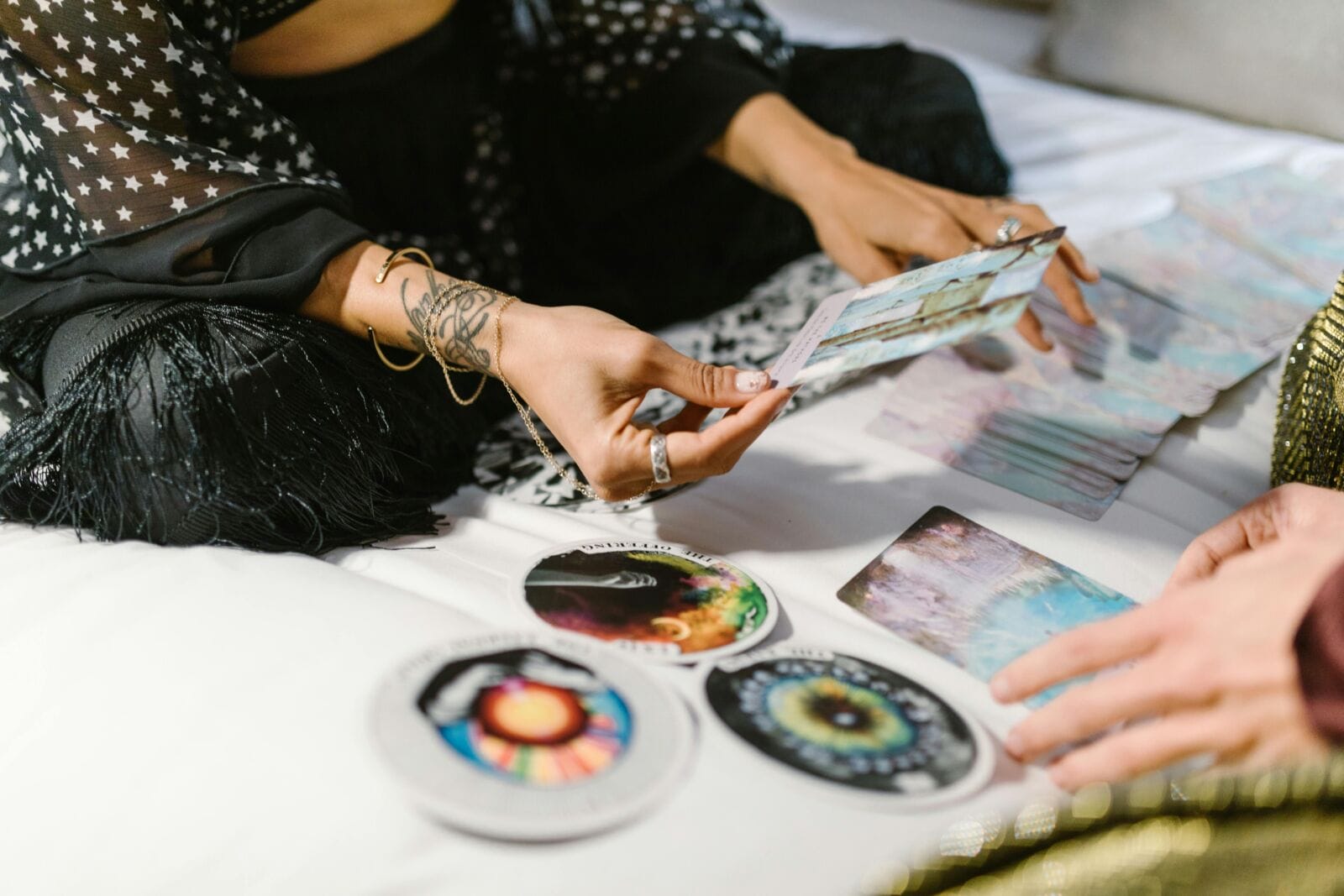The Tarot serves as a symbolic map of consciousness, offering insights into the spiritual and practical aspects of our life journey. Tarot reading involves drawing wisdom and guidance from specific layouts (or spreads) of Tarot cards.
Contrary to popular belief, the cards don’t predict the future outright, and you don’t need to be psychic to interpret them. Instead, they provide clarity and awareness of what your higher self already knows. The origins of the Tarot remain uncertain, though documented references date back to 14th-century Europe. The Tarot, as we recognize it today, has been used as an oracle since the early 17th century.
The Meaning of the Tarot
The Tarot deck has 22 Major Arcana cards, which reveal significant life events or themes, and 56 Minor Arcana cards, which focus on daily occurrences. The Minor Arcana consists of four suits—Wands, Swords, Cups, and Pentacles — each symbolizing one of the four elements: Fire, Air, Water, and Earth.
These suits reflect different aspects of human experience, such as personality traits, challenges, and opportunities. Each suit contains 14 cards, numbered Ace through Ten, plus the Court Cards (Page, Knight, Queen, and King).
While deck names and designs may vary, the underlying meanings remain universal. For example, in some decks, the Knight may replace the King. Most decks come with a guidebook that details specific naming and interpretations.
The Minor Arcana represents the ups and downs of daily life, while the Major Arcana reflects larger life lessons and milestones. These often align with Joseph Campbell’s concept of the Hero’s Journey. The 22 phases appear throughout one’s life in no particular order and often repeat.
Tarot and Spirituality
Tarot has long been intertwined with spirituality, offering a unique path for personal growth and self-discovery. Rather than being merely a tool for divination, Tarot acts as a mirror to the soul, helping individuals explore their inner world and connect with their higher self. The cards encourage reflection on deep-seated emotions, desires, and challenges, providing clarity and insight into one’s spiritual journey.
By meditating on the symbols within each card, many find that Tarot serves as a guide through the process of self-awareness and transformation, uncovering truths that lead to a more fulfilling life. Tarot can be seen as a spiritual practice that deepens your connection to the universe and your intuition. Each reading invites you to engage with the larger mysteries of life, revealing patterns that guide you toward greater understanding and enlightenment. Whether used in moments of uncertainty or as part of a regular spiritual practice, Tarot fosters a space for introspection, helping you align with your purpose and navigate life’s challenges with more wisdom and compassion.
Types of Tarot Spreads
There are numerous Tarot spreads, with the Celtic Cross being the most well-known. This spread typically includes 11 cards, including a “Significator.” Other spreads, like the Tree of Life, the Planetary spread, or the Pentagram spread, offer different insights depending on their focus.
Simple three-card spreads, often interpreted as Past-Present-Future, Mind-Body-Spirit, or Situation-Action-Outcome, provide flexible and varied readings. When searching for the best online tarot reading, you’ll find practitioners who use these spreads to offer personalized insights into your specific questions or concerns, making Tarot accessible to anyone from anywhere.
Reversed Tarot Cards
Tarot cards typically feature single images, and during shuffling, they can sometimes appear upside-down in a reading. Reversed Tarot cards are often interpreted as the energy of the card being blocked, diminished, or reversed. Some believe that reversed cards reflect inner resistance to the card’s significance, while others interpret them as revealing an opposite or inverted meaning.
Many traditional Tarot guides, such as those accompanying the Rider-Waite deck, provide specific meanings for reversed cards. However, when learning Tarot, you may prefer to avoid the complexity of reversals by turning all cards right-side-up. This allows you to explore the full spectrum of energy from each card without confusion.
Which Is the Best Tarot Deck?
There is no singular “best” Tarot deck. The Rider-Waite is one of the most popular and oldest decks, with artwork dating back to the early 1900s, but there are hundreds of decks with diverse themes. These range from fiction-based themes like Lord of the Rings or Alice in Wonderland to more whimsical ones like Gummy Bears or My Little Pony. For more serious or symbolic decks, you can explore the Crowley Thoth Tarot, The Hermetic Tarot, or The Wildwood Tarot. Choosing a deck is a personal experience, and it’s best to follow your intuition toward the themes and imagery that resonate with your spiritual journey.
Notable Cards in the Major Arcana
The Major Arcana’s 22 cards each represent significant archetypes or life stages. Here are some highlights:
- The Fool (0): Signifies new beginnings and adventure, encouraging bold leaps into uncharted territory.
- The Magician (I): Reflects communication and action, symbolizing a time to manifest your desires.
- The High Priestess (II): Represents intuition and self-trust, urging you to tap into your inner wisdom.
- The Empress (III): Embodies love, creativity, and nurturing, emphasizing the balance between giving and receiving.
- The Emperor (IV): Reflects leadership and personal power, often appearing when it’s time to take control of your life.
Other important cards include The Lovers (VI), representing relationships and decisions, and The Wheel of Fortune (X), symbolizing change and new opportunities. The Major Arcana explores the cyclical nature of life, with each card highlighting universal experiences.
The Cyclical Nature of Tarot
The Major Arcana reflects the recurring cycles of life, from The Fool’s journey of beginnings to The World’s completion of that cycle. As these cycles repeat, the lessons they offer evolve, yet the themes remain universal. Whether you’re beginning a new phase or completing one, Tarot offers valuable insight into life’s constant transformations.




